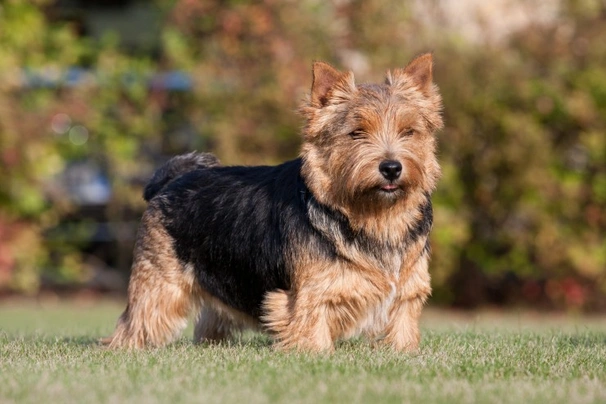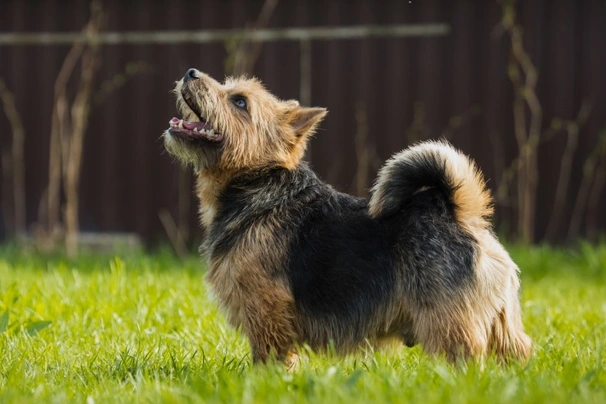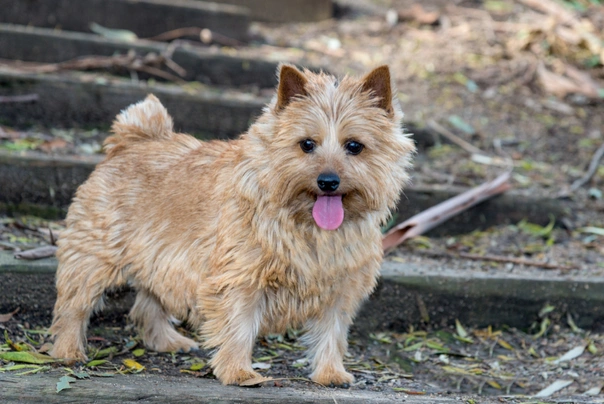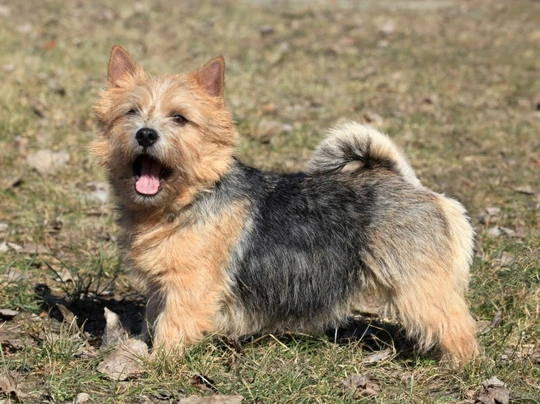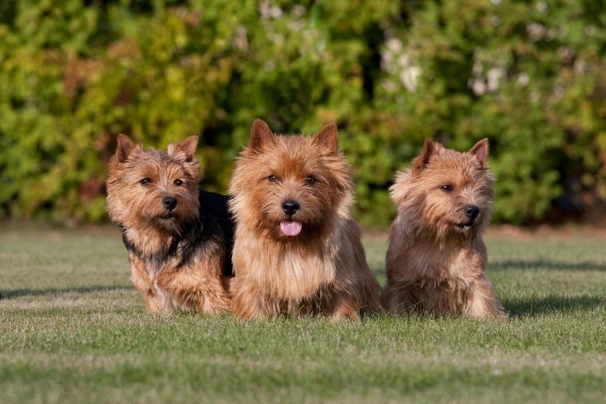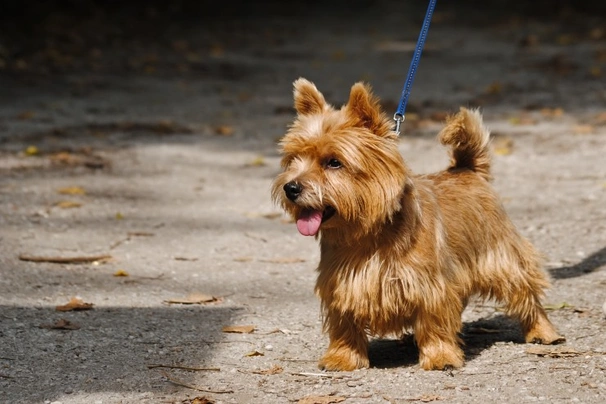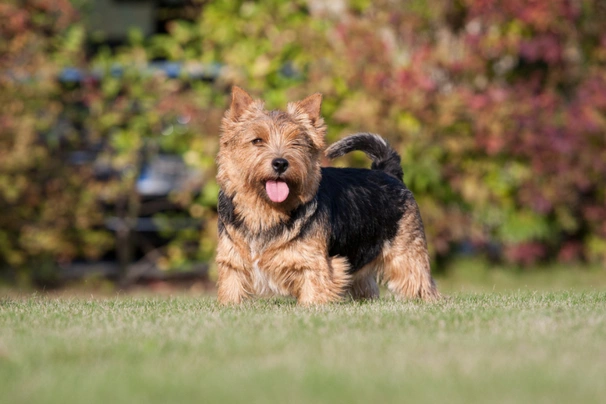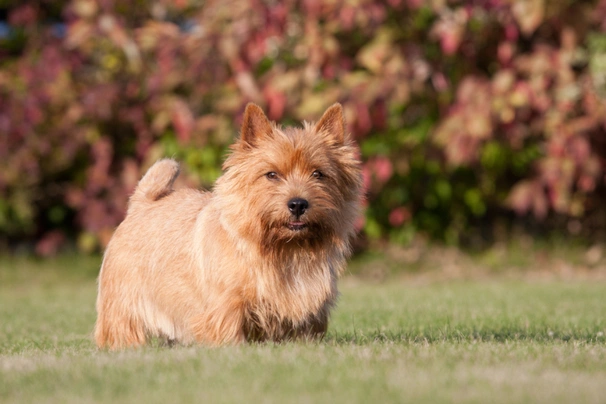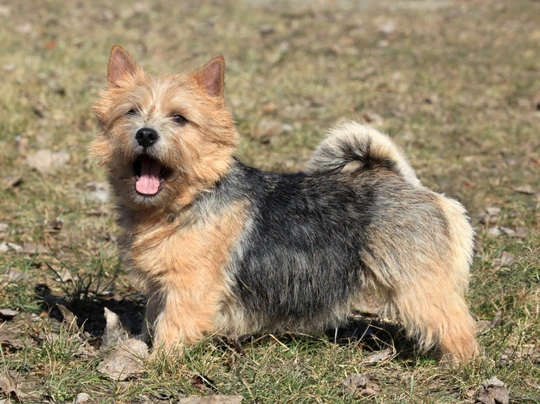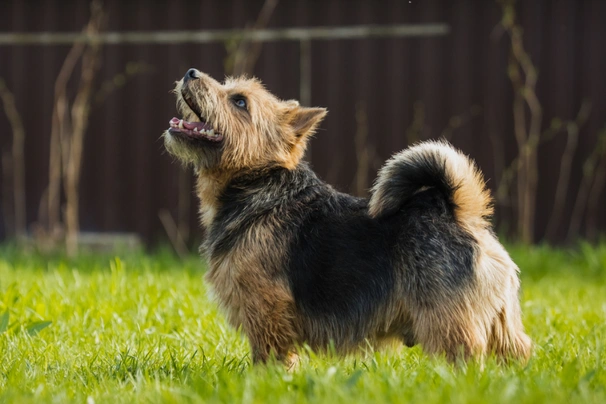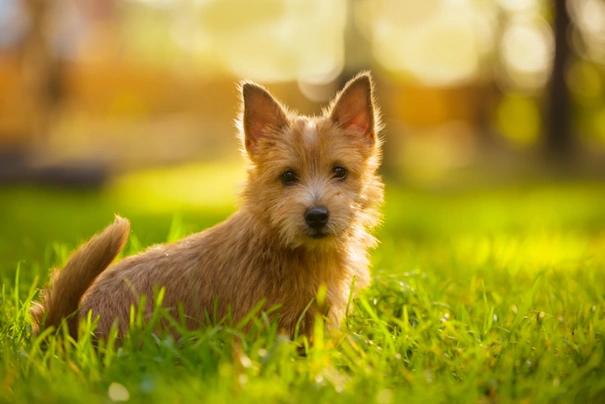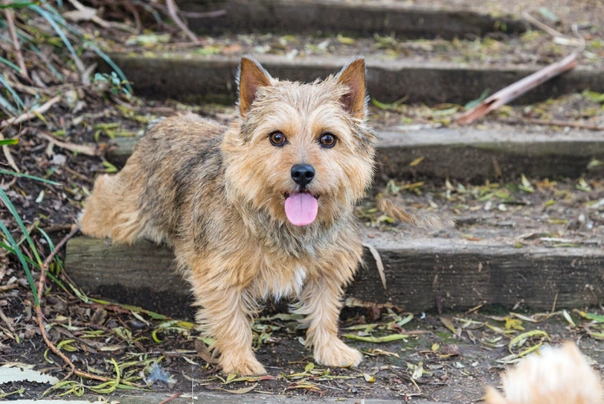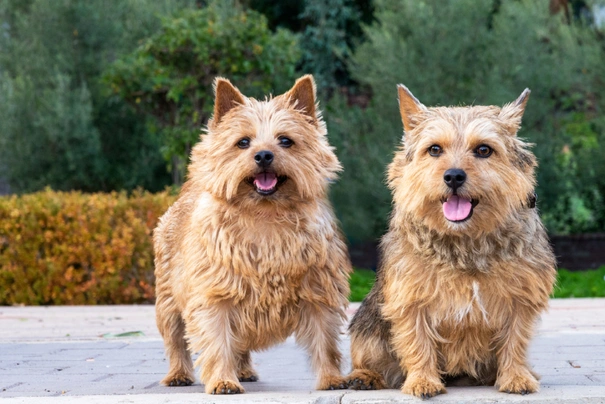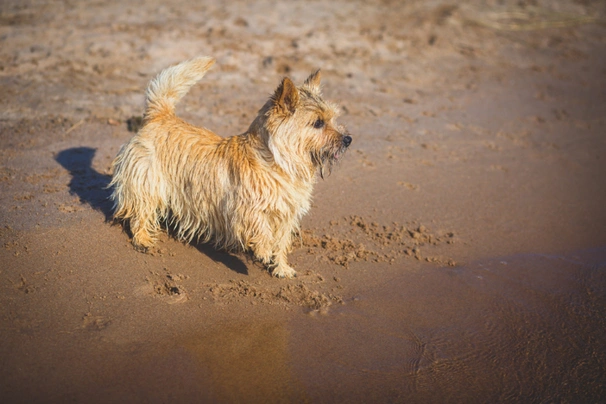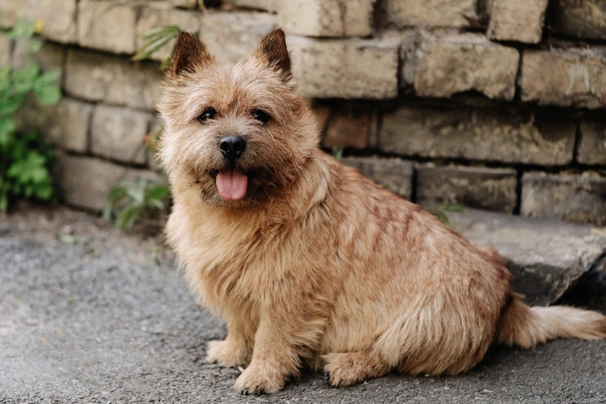Norwich Terrier
Pros
Cons
Introduction of the Norwich Terrier
The Norwich Terrier is the smallest of all working terriers and were named after the county where they were first bred during the early part of the twentieth century. They look very much like their Norfolk Terrier cousins with the difference being that they have pricked ears whereas Norfolks boast having drop ears. Although once a very popular choice as both a working dog and family pet these charming affectionate and lively dogs have fallen out of favour over recent times. As such they have been placed on The Kennel Club's list of vulnerable native breeds.
History of the Norwich Terrier
Norwich Terriers were bred to keep vermin under control and they proved to be excellent ratters. These charming little terriers have been around for over a hundred years and it is thought their ancestors could well be the Border Terrier the Cairn Terrier and Ireland's Red Terrier. The Norfolk and Norwich Terriers were developed by Frank Jones by crossing various working terriers with an end goal being to produce smaller dogs. His endeavours produced terriers very capable of digging into small burrows and soon these little terriers were to find favour with many people throughout the land.
The Norwich Terriers we see today started out as a show breed along with Norfolk Terriers in 1932. However it was only after the end of World War II that breeders crossed the Norwich and the Norfolk Terriers to produce two distinct breeds with the drop ears of the Norfolk Terrier becoming their own unique hallmark and hence they were renamed "Norfolk" terriers to distinguish them from Norwich Terriers with their "pricked" ears.
Throughout time terriers have been one of the more popular choices with not only hunters but the farming community of East Anglia which is a marshy area of the land where vermin were a real problem. These small terrier-types are thought to be the ancestors of early Norwich Terriers. With this said undergraduates of Cambridge University are known to have purchased some small terriers because of a rat problem they had too. They bought the terriers from a man called Charles Doggy Lawrence and were to become known in the region as “Trumpington Terriers” which is the name of the street where the students lived. It is thought that these terriers were developed using small Irish Terriers and a larger version of the Yorkshire Terrier.
A man called Mr Jodrell Hopkins bought an Aberdeen-type terrier female with a brindle coat at around the same time as the students. He mated her to a dog owned by Doggy Lawrence named Jack a terrier with a long silky coat and the result was a small red puppy with a shaggy harsh coat and pricked ears called “Rags”. He was offered as a gift to a man called Jack Cooke who was the Master of the Norwich Staghounds. Jodrell Hopkins continued his breeding programme with an end goal being to develop red terriers true to type although some of them had grizzle or brindle coats too but never one coat colour namely black and tan.
After getting rid of his original female a terrier that killed everything in sight Rags was mated to a white smooth-haired terrier with pricked ears called Ninety a dog that was owned by a local vet. They produced several litters and all the puppies had red coats. Some were purchased by the First Whip of the Norwich Staghounds a Mr Jones who later began a breeding programme of his own. He sold his “red” terrier puppies to people throughout the land with some even being taken over to America where they were to become known as “Jack Terriers”.
Jones continued to cross his terriers with other terrier-types which included Trumpington Terriers. One puppy was sold to a Mr Jack Read in 1909 who was to become the president of the first Breed Club. He also began a breeding programme using Bedlington terriers and a brown coated Staffordshire Bull Terrier owned by the Countess of Kimberley. He also used Irish Terriers to create the sort of terrier he wanted that boasted the right coat character and looks which included prick and drop ears.
Other breed enthusiasts were Mr. W E West who used a female he obtained from Roughrider Jones and Mrs Fagan who owned a female called Brownie to establish her line. Today a lot of very well-known champion Norwich Terriers can trace their ancestry back to Brownie. Because there were so many breeding programmes taking place it proved difficult to establish a breed standard.
Sadly over the ensuing years although interest in the breed was at one time quite high today numbers have dropped and as such the Norwich Terrier has been placed on the Kennel Club’s list of vulnerable native breeds and anyone wishing to share a home with one of these energetic loyal and intelligent terriers would need to register their interest with breeders first.
Interesting facts about the breed
- Is the Norwich Terrier a vulnerable breed? Yes they have been placed on the Kennel Club’s list of vulnerable native breeds and few well-bred puppies are registered with the KC every year
- Norwich Terriers are among one of the smallest terrier breeds
- The Norwich Terrier was officially recognised by The Kennel Club in 1932
- Traditionally a Norwich Terrier’s tail was always docked but since the law banning the procedure came into effect in 2007 tail docking is now illegal with the exception being for some working breeds and if a dog suffers from some sort of health issue that requires their tails to be docked. The procedure must be agreed and authorised before being performed by a qualified vet. Failure to have the right documentation carries heavy fines
Appearance of the Norwich Terrier
Height at the withers: Males 24 - 25.5 cm Females 24 - 25.5 cm
Average weight: Males 5 - 5.5 kg Females 5 - 5.5 kg
Norwich Terriers are very similar looking to the Norfolk Terrier with the main difference being they have pricked ears. They have rather wedge-shaped muzzles and well-defined stops with the top of their head being slightly domed and boasting a nice width between a dog's ears. Their eyes are quite small and oval in shape being dark in colour with these terriers boasting a bright keen expression in them.
Ears are set well apart on the head which dogs hold erect. They have pointed tips and are medium in size. When relaxed a Norwich Terrier holds their ears laid back. They have a strong jaw with a perfect scissor bite where their upper teeth neatly overlap their lower ones. Necks are strong and quite long flowing nicely into a dog's shoulders. Front legs are short straight and powerful. Their backs are short with a good depth and long well sprung ribs. Toplines are level and loins are short.
Their back legs are strong muscular and broad. Feet are well rounded nicely padded and quite cat-like. Tails are moderately long which adds to the overall balanced look of these terriers being thicker at the base before it tapers to the tip. Dogs carry their tails straight and quite gaily when they are excited or alert.
When it comes to their coat the Norwich Terrier boasts a double coat with the topcoat being wiry hard straight and close lying whereas their undercoat is softer and much denser. The hair on a dog's neck is longer and rougher forming a ruff that frames the face. The hair on their head ears is shorter and smooth but dogs have eyebrows and whiskers. The accepted breed colours are as follows:
- Black & Tan
- Grizzle
- Red
- Red Grizzle
- Red Wheaten
- Wheaten
It is worth noting that the accepted breed colours for Kennel Club registration can differ from those set out in the breed standard which are as follows:
- All shades of red
- Wheaten
- Black and tan
- Grizzle
It is worth noting that any white patches or marks in a dog’s coat are highly undesirable under the Breed Standard.
Gait/movement
When a Norwich Terrier moves they do so with great purpose moving their front legs in a straight forward action with their back legs tracking their front ones. Their hocks move parallel and flexing so that a dog’s paw pads can be seen.
Faults
The Kennel Club frowns on any exaggerations or departures from the breed standard and would judge the faults on how much they affect a dog's overall health and wellbeing as well as their ability to perform.
Males should have both testicles fully descended into their scrotums and it is worth noting that a dog can be a little lighter or heavier as well as slightly taller or shorter than set out in the Kennel Club breed standard which is only given as a guideline.
Temperament of the Norwich Terrier
Affectionate active intelligent and courageous the Norwich Terrier is known to be a very good choice as a family pet. These little dogs get on with everyone including children and other animals with no problems whatsoever which is especially true of dogs that have been well socialised from a young age. With this said the Norwich Terrier is known to be a little bit suspicious of strangers and new situations although they would rarely show any sort of aggressive behaviour towards anyone they did not know preferring to just keep their distance rather than get up close.
Puppies must be well socialised from a young age for them to grow up to be confident adult dogs no matter where they find themselves. They are very active and energetic by nature which means they are never happier than when they are given something to dog and because they are so intelligent these terriers need as much mental stimulation as possible on a daily basis to prevent boredom from setting in. When Norwich Terriers are bored they find new ways to entertain and amuse themselves which often results in them developing some unwanted and destructive behaviours around the home which includes digging and excessive barking
Are they a good choice for first time owners?
Norwich Terriers are a good choice for first time dog owners providing they have the time to dedicate to such an intelligent high-energy canine companion and one that needs to be kept busy both mentally and physically for them to be truly happy dogs.
What about prey drive?
Like all “terriers” the Norwich Terrier has a very high prey drive and will happily ignore a command to chase anything that tries to run away from them or which they spot in the distance. As such care must be taken as to where and when a dog can run off the lead more especially if there is wildlife and/or livestock close by.
What about playfulness?
Norwich Terriers have a very playful side to their natures and love to entertain and be entertained. They are known to be a little mischievous when the mood takes them and being so clever they quickly learn how to get their own way when they want something.
What about adaptability?
Although small in stature Norwich Terriers as previously mentioned like being kept busy and as such they are better suited to people who lead active outdoor lives and who would like an alert active and devoted canine companion at their side.
What about separation anxiety?
Although Norwich Terriers form strong ties with their families they are not known to suffer from separation anxiety although no dog likes to be left to their own devices for longer periods of time which can lead to them being destructive around the home which is a dog's way of relieving any stress they are feeling and a way to keep themselves entertained and this includes incessant barking to get some attention.
What about excessive barking?
Norwich Terriers are known to like the sound of their own voices a little too much which is something that needs to be gently nipped in the bud when a dog is still young being careful not to frighten them. However some owners find that even with careful and gentle training it is almost impossible to prevent their dogs from barking just for the sake of it.
Do Norwich Terriers like water?
Most Norwich Terriers like swimming and will take to the water whenever they can more especially when the weather is hot. However if anyone who owns a dog that does not like water should never force them to go in because it would just end up scaring them. With this said care should always be taken when walking a Norwich Terrier off the lead anywhere near more dangerous watercourses just in case a dog decides to leap in and then needs rescuing because they cannot get out of the water on their own.
Are Norwich Terriers good watchdogs?
Because a Norwich Terrier is always on the alert they make good watchdogs. However because they like to bark at just about anything and for any reason it makes it harder for an owner to know if there is something amiss or not. With this said rarely would a dog show any sort of aggression towards a stranger preferring to keep their distance and bark.
Intelligence / Trainability of the Norwich Terrier
Norwich Terriers are known for their intelligence and the fact they love to please. However like a lot of other terriers they can be a little wilful when they want to be which can make training them a bit of a challenge. As such their training has to start as early as possible and it has to be consistent for dogs to respond well to any commands they are given.
Being quite sensitive by nature the Norwich Terrier does not respond well to any sort of harsh correction or heavy-handed training methods. They do answer well to positive reinforcement and will look to their owners for guidance and direction as long as they know their place in the pack and who is alpha dog in a household for them to be truly obedient dogs.
There have been reports of Norwich Terriers being difficult to housetrain but with perseverance and a lot of understanding they can be taught to do their business outside it may just take a little longer than with other breeds.
Like all puppies the Norwich Terrier is incredibly cute when young which means it is all too easy to spoil them when they first arrive in their new homes. However as soon as a puppy is nicely settled owners must start out as they mean to go on to prevent any unwanted behaviours from developing. This means laying down ground rules limits and boundaries so that a puppy understands what is expected of them. It also helps establish a pecking order and who the alpha dog is in a household. The first commands a puppy should be taught are as follows:
- Come
- Sit
- Stay
- Heel
- Quiet
- Leave it
- Down
- Bed
Children and other
Norwich Terriers are very outgoing and affectionate dogs by nature and as such they get on well with children. However because they can be a little boisterous at times especially when they are still puppies any interaction between children and a dog should be supervised by an adult to ensure playtime does not get too rough.
If well socialised from a young age and they have grown up with a cat in the house a Norwich Terrier generally gets on well with a feline companion. However they may just want to give chase on the odd occasion especially if a neighbour's cat dares to venture too close to them. Any contact with smaller animals and pets should be avoided because their terrier traits might just get the better of them with disastrous results.
Health of the Norwich Terrier
The average life expectancy of a Norwich Terrier is between 12 and 16 years when properly cared for and fed an appropriate good quality diet to suit their ages.
Like so many other breeds the Norwich Terrier is known to suffer from a few hereditary health issues which are worth knowing about if you are planning share your home with one of these active and good-looking dogs. The conditions that seem to affect the breed the most include the following:
- Primary lens luxation (PLL) – dogs should be DNA tested
- Cataracts
- Epileptoid cramping syndrome
- Upper airway syndrome
- Patellar luxation
- Heart murmurs
It is worth noting that the breed average COI currently stands at 8.1% with The UK Kennel Club.
What about vaccinations?
Norwich Terrier puppies would have been given their initial vaccinations before being sold but it is up to their new owners to make sure they have their follow-up shots in a timely manner with the vaccination schedule for puppies being as follows:
- 10 -12 weeks old bearing in mind that a puppy would not have full protection straight away but would be fully protected 2 weeks after they have had their second vaccination
There has been a lot of discussion about the need for dogs to have boosters. As such it's best to talk to a vet before making a final decision on whether a dog should continue to have annual vaccinations which are known as boosters.
What about spaying and neutering?
A lot of vets these days recommend waiting until dogs are slightly older before spaying and neutering them which means they are more mature before undergoing the procedures. As such they advise neutering males and spaying females when they are between the ages of 6 to 9 months old and sometimes even when a dog is 12 months old.
Other vets recommend spaying and neutering dogs when they are 6 months old but never any earlier unless for medical reasons. With this said many breeds are different and it is always advisable to discuss things with a vet and then follow their advice on when a dog should be spayed or neutered.
What about obesity problems?
As with other breeds some Norwich Terriers gain weight after they have been spayed or neutered and it's important to keep an eye on a dog's waistline just in case they do. If a dog starts to put on weight it's important to adjust their daily calorie intake and to up the amount of exercise they are given. Older dogs too are more prone to gaining weight and again it's essential they be fed and exercised accordingly because obesity can shorten a dog's life by several years. The reason being that it puts a lot of extra strain on a dog's internal organs including the heart which could prove fatal.
What about allergies?
Norwich Terriers are not known to be prone to suffering from allergies but it's important for a dog to see a vet sooner rather than later if one flares up. Allergies can be notoriously hard to clear up and finding the triggers can be challenging. With this said a vet would be able to make a dog with an allergy more comfortable while they try to find out the triggers which could include the following:
- Certain dog foods that contain high levels of grains and other cereal-type fillers
- Airborne pollens
- Dust mites
- Environment
- Flea and tick bites
- Chemicals found in everyday household cleaning products
Participating in health schemes
All responsible Norwich Terrier breeders would ensure that their stud dogs are tested for known hereditary and congenital health issues known to affect the breed by using the following schemes:
What about breed specific breeding restrictions?
Apart from the standard breeding restrictions that are in place for all Kennel Club registered breeds there are no other breed specific breeding restrictions in place for the Norwich Terrier.
What about Assured Breeder Requirements?
Currently there are no Kennel Club Assured Breeder requirements in place for the Norwich Terrier.
Caring for the Norwich Terrier
As with any other breed Norwich Terriers need to be groomed on a regular basis to make sure their coats and skin are kept in top condition. They also need to be given regular daily exercise to ensure they remain fit and healthy. On top of this dogs need to be fed good quality food that meets all their nutritional needs throughout their lives.
Caring for a Norwich Terrier puppy
Norwich Terrier puppies are boisterous and full of life which means it's essential for homes and gardens to be puppy-proofed well in advance of their arrival. A responsible breeder would have well socialised their puppies which always leads to more outgoing confident and friendly dogs right from the word go. With this said any puppy is going to feel vulnerable when they leave their mother and littermates which must be taken into account. The longer a puppy can remain with their mother the better although it should never be for too long either.
It's best to pick a puppy up when people are going to be around for the first week or so which is the time needed for a puppy to settle in. Puppy-proofing the home and garden means putting away any tools and other implements that a boisterous puppy might injure themselves on. Electric wires and cables must be put out of their reach because puppies love chewing on things. Toxic plants should be removed from flowerbeds and the home too.
Puppies need to sleep a lot to grow and develop as they should which means setting up a quiet area that's not too out of the way means they can retreat to it when they want to nap and it's important not to disturb them when they are sleeping. It's also a good idea to keep "playtime" nice and calm inside the house and to have a more active "playtime" outside in the garden which means puppies quickly learn to be less boisterous when they are inside.
The documentation a breeder provides for a puppy must have all the details of their worming date and the product used as well as the information relating to their microchip. It is essential for puppies to be wormed again keeping to a schedule which is as follows:
- Puppies should be wormed at 6 months old
- They need to be wormed again when they are 8 months old
- Puppies should be wormed when they are 10 months old
- They need to be wormed when they are 12 months old
Things you'll need for your puppy
There are certain items that new owners need to already have in the home prior to bringing a new puppy home. It's often a good idea to restrict how much space a puppy plays in more especially when you can't keep an eye on what they get up to bearing in mind that puppies are often quite boisterous which means investing in puppy gates or a large enough playpen that allows a puppy the room to express themselves while keeping them safe too. The items needed are therefore as follows:
- Good quality puppy or baby gates to fit on doors
- A good well-made playpen that's large enough for a puppy to play in so they can really express themselves as puppies like to do
- Lots of well-made toys which must include good quality chews suitable for puppies to gnaw on bearing in mind that a puppy will start teething anything from when they are 3 to 8 months old
- Good quality feed and water bowls which ideally should be ceramic rather than plastic or metal
- A grooming glove
- A slicker brush or soft bristle brush
- Dog specific toothpaste and a toothbrush
- Scissors with rounded ends
- Nail clippers
- Puppy shampoo and conditioner which must be specifically formulated for use on dogs
- A well-made dog collar or harness
- A couple of strong dog leads
- A well-made dog bed that's not too small or too big
- A well-made dog crate for use in the car and in the home that's large enough for a puppy to move around in
- Baby blankets to put in your puppy's crate and in their beds for when they want to nap or go to sleep at night
Keeping the noise down
All puppies are sensitive to noise including Norwich Terrier puppies. It's important to keep the noise levels down when a new puppy arrives in the home. TVs and music should not be played too loud which could end up stressing a small puppy out making them withdrawn timid and shy.
Keeping vet appointments
As previously mentioned Norwich Terrier puppies would have been given their first vaccinations by the breeders but they must have their follow up shots which is up to their new owners to organise. The vaccination schedule for puppies is as follows:
- 10 -12 weeks old bearing in mind that a puppy would not have full protection straight away but would only be fully protected 2 weeks after they have had their second vaccination
When it comes to boosters it's best to discuss these with a vet because there is a lot of debate about whether a dog really needs them after a certain time. However if a dog ever needed to go into kennels their vaccinations would need to be fully up to date.
What about older Norwich Terriers when they reach their senior years?
Older Norwich Terriers need lots of special care because as they reach their golden years they are more at risk of developing certain health concerns. Physically a dog's muzzle may start to go grey but there will be other noticeable changes too which includes the following:
- Coats become coarser
- A loss of muscle tone
- Dogs can either become overweight or underweight
- They have reduced strength and stamina
- Older dogs have difficulty regulating their body temperature
- They often develop arthritis
- Immune systems do not work as efficiently as they once did which means dogs are more susceptible to infections
- Older dogs change mentally too which means their response time tends to be slower as such they develop the following:
- They respond less to external stimuli due to impaired vision or hearing
- They tend to be a little pickier about their food
- They have a lower pain threshold
- Become intolerant of any change
- Often an older dog can feel disorientated
Living with a Norwich Terrier in their golden years means taking on a few more responsibilities but these are easily managed and should include looking at their diet the amount of exercise they are given how often their dog beds need changing and keeping an eye on the condition of their teeth.
Older Norwich Terriers need to be fed a good quality diet that meets their needs at this stage of their lives all the while keeping a close eye on a dog's weight. A rough feeding guide for older dogs is as follows bearing in mind they should be fed highly digestible food that does not contain any additives:
- Protein content should be anything from 14 – 21%
- Fat content should be less than 10%
- Fibre content should be less than 4%
- Calcium content should be 0.5 – 0.8%
- Phosphorous content should be 0.4 – 0.7%
- Sodium content should be 0.2 – 0.4%
Older Norwich Terriers don't need to be given the same amount of daily exercise as a younger dog but they still need the right amount of physical activity to maintain muscle tone and to prevent a dog from putting on too much weight. All dogs need access to fresh clean water and this is especially true of older dogs when they reach their golden years because they are more at risk of developing kidney disorders.
Grooming of the Norwich Terrier
A Norwich Terrier has a coarse and wiry coat and as such they are low maintenance in the grooming department. A weekly brush is all that's needed to keep their coats tidy and tangle-free. However they do need to be hand stripped at least twice a year which is best left up to a professional dog groomer. This makes it that much easier to keep on top of things in between visits to the grooming parlour.
Puppies need to be introduced to all the tools needed to keep their coats and skin in top condition and it's important to touch their ears paws and other parts of their body which makes it a lot easier to trim nails and check an adult dog's ears further down the line. It's important to check a dog's ears on a regular basis and to clean them when necessary. If too much wax is allowed to build up in a dog's ears it can lead to a painful infection which can be hard to clear up. In short prevention is often easier than cure when it comes to ear infections.
Exercise of the Norwich Terrier
Norwich Terriers are known to be high-energy little dogs and much like other terriers they need to be given the right amount of daily exercise and mental stimulation to be truly happy well-rounded and obedient dogs. They need at least one hour's exercise every day and as much "playtime" as possible to prevent dogs from developing unwanted and often destructive behaviours around the home.
A shorter walk in the morning would be fine but a longer more interesting one in the afternoon is a must. These dogs also like to be able to roam around a back garden as often as possible so they can really let off steam. However the fencing has to be extremely secure to keep these lively active dogs in because if they find a weakness in the fence they will soon escape out and get into all sorts of trouble bearing in mind that there is nothing these little terriers enjoy more than digging.
With this said Norwich Terrier puppies should not be given too much exercise because their joints and bones are still growing and too much pressure on them could result in causing a dog a few problems later on in their lives. They should not be allowed to jump up or off furniture nor should they be allowed to run up and down the stairs because this puts too much pressure on their still growing joints and limbs.
Feeding of the Norwich Terrier
If you get a Norwich Terrier puppy from a breeder they would give you a feeding schedule and it's important to stick to the same routine feeding the same puppy food to avoid any tummy upsets. You can change a puppy's diet but this needs to be done very gradually always making sure they don't develop any digestive upsets and if they do it's best to put them back on their original diet and to discuss things with the vet before attempting to change it again.
Older dogs are not known to be fussy or finicky eaters but this does not mean you can feed them a lower quality diet. It's best to feed a mature dog twice a day once in the morning and then again in the evening making sure it's good quality food that meets all their nutritional requirements. It's also important that dogs be given the right amount of exercise so they burn off any excess calories or they might gain too much weight which can lead to all sorts of health issues. Obesity can shorten a dog's life by several years so it's important to keep an eye on their waistline from the word go.
Feeding guide for a Norwich Terrier puppy
Puppies need to be fed a highly nutritious good quality diet for them to develop and grow as they should. As a rough guide a Norwich Terrier puppy can be fed the following amounts every day making sure their meals are evenly spread out throughout the day and it's best to feed them 3 or 4 times a day:
- 2 months old - 92g to 102g depending on puppy's build
- 3 months old - 108g to 118g depending on puppy's build
- 4 months old - 114g to 124g depending on puppy's build
- 5 months old - 115g to 125g depending on puppy's build
- 6 months old - 114 g to 124g depending on puppy's build
- 7 months old - 92g to 112g depending on puppy's build
- 8 months old - 90g to 100g depending on puppy's build
- 9 months old - 79g to 89g depending on puppy's build
- 10 months old - 78g to 88g depending on puppy's build
Once a puppy is 11 months old they can be fed adult dog food.
Feeding guide for an adult Norwich Terrier
Once fully mature an adult Norwich Terrier should be fed a good quality diet to ensure their continued good health. As a rough guide an adult dog can be fed the following amounts every day:
- Dogs weighing 5 kg can be fed 80g to 93g depending on activity
- Dogs weighing 5.5 kg can be fed 85g to 98g depending on activity
Norwich Terrier price
If you are looking to buy a Norwich Terrier you would need to pay anything from £300 to over £600 for a well-bred pedigree puppy. The cost of insuring a male 3-year-old Norwich Terrier in northern England would be £19.98 a month for basic cover but for a lifetime policy this would set you back £42.90 a month (quote as of May2018). When insurance companies calculate a pet's premium they factor in several things which includes where you live in the UK and a dog's age and whether they are neutered or spayed amongst other things.
When it comes to food costs you need to buy the best quality food whether wet or dry to feed your dog throughout their lives making sure it suits the different stages of their lives. This would set you back between £30 - £40 a month. On top of this you would need to factor in veterinary costs if you want to share your home with a Norwich Terrier and this includes their initial vaccinations their annual boosters the cost of neutering or spaying your dog when the time is right and their yearly health checks all of which quickly adds up to over a £800 a year.
As a rough guide the average cost to keep and care for a Norwich Terrier would be between £50 to £90 a month depending on the level of insurance cover you opt to buy for your dog but this does not include the initial cost of buying a well-bred Kennel Club registered pedigree Norwich Terrier puppy.
Buying advice
When visiting and buying any puppy or dog there are many important things to consider and questions to ask of the breeder/seller. You can read our generic puppy/dog advice here which includes making sure you see the puppy with its mother and to verify that the dog has been wormed and microchipped.
Finding Norwich Terrier puppies can prove challenging and very few are registered with the Kennel Club every year which means that well-bred puppies command a lot of money. As such with Norwich Terriers there is specific advice questions and protocols to follow when buying a puppy which are as follows:
- Beware of online scams and how to avoid them. You may see online and other adverts by scammers showing images of beautiful Norwich Terrierpuppies for sale at very low prices. However the sellers ask buyers for money up front before agreeing to deliver a puppy to a new home. Potential buyers should never buy a puppy unseen and should never pay a deposit or any other money online to a seller. You should always visit the pet at the sellers home to confirm they are genuine and make a note of their address.
- As previously touched upon waiting lists can be long and Norwich Terrier puppies can be expensive. As such some amateur breeders/people who breed from a dam far too often so they can make a quick profit without caring for the welfare of the puppies their dam or the breed in general. Under Kennel Club rules a dam can only produce 4 litters and she must be between a certain age to do so. Anyone wishing to buy a Norwich Terrier puppy should think very carefully about who they purchase their puppy from and should always ask to see the relevant paperwork pertaining to a puppy's lineage their vaccinations and their microchipping.
- Prospective owners should be very careful when considering buying an extra small puppy because all too often they suffer from very serious health issues and no responsible breeder would purposefully breed dogs so they are too small.
- Traditionally a Norwich Terrier’s tail was always docked but since the law banning the procedure came into effect in 2007 tail docking is now illegal with the exception being for some working breeds and if a dog suffers from some sort of health issue that requires their tails to be docked. The procedure must be agreed and authorised before being performed by a qualified vet failure to have the correct paperwork would result in heavy fines.

Norwich Terrier
£1,200
Morwich Terrier
£1,200
